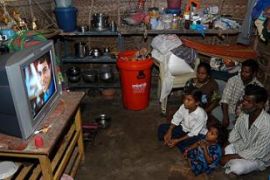Fake TV ‘sting’ rocks India
False and sensational reports bring disrepute to television journalism in India.

Published On 13 Sep 2007
The victimisation of Uma Khurana, a maths teacher in a Delhi government school, has led to viewers and authorities questioning the honesty of television “stings” and prompting other television channels to engage in serious “soul-searching,” observers say.
Truth ‘distorted’
Many Indian television channels, in the search of sensationalism to seek extra viewers in a crowded and competitative marketplace, are being accused of burying ethical journalism and distorting the truth.
“Indian journalism has never been more competitive and adversarial,” admits Tarun Tejpal, the editor of Tehelka, an investigative weekly that regularly broadcasts undercover documentaries.
There are now more than 100 24-hour news channels crowding the airwaves in India, desperate race to grab audiences.
“Our journalist was a criminal,” Sudhir Chowdhury, the editor of Live India, has said.
Police believe Khurana was the victim of a criminal conspiracy hatched by Prakash Singh, the Live India reporter, and someone else who held grudges against the teacher.
The “sting” fell apart when it was revealed that the alleged victim who narrated her ordeal on camera was an aspiring journalist.
Blackmail attempt
Khurana spent 10 days in jail before being let out on bail on Tuesday.
“She was more of a victim than an offender”, judge Alok Agrawal said, while ordering her bail.
But she is not the only victim.
Rameshwar Oraon, a member of the Indian parliament, also found himself on the wrong side of prying cameras.
On Monday, three men were arrested for posing as journalists and attempting to blackmail him.
The three men tried to bribe Oraon – then announced they were conducting a TV news “sting”.
They told him they would quash the report if he paid them.
But Oraon refused and the three were later charged with impersonation and extortion.
‘Collateral damage’
Many people now fear that the fake stings could give professional investigative journalism a bad name.
Others are also concerned it may give the government an excuse to try and rein in the media.
“The collateral damage could be huge with the credibility of journalists being tainted by a few rotten apples,” Rabi Das, a media analyst, said.
Journalists have long used undercover or “sting” operations as investigative tools in India, sometimes reaching into the country’s most hallowed offices.
In one of the most famous examples, in 2001 Tehelka showed images of senior politicians from then ruling coalition led by the Bharatiya Janata Party(BJP) receiving cash from journalists posing as defence contractors.
The sensational report led to the resignation of the defence minister and president of the BJP.
Looming in the background of the current scandal is the government’s proposed broadcast bill, which includes a highly regulated media code that critics say is “draconian”.
Priya Ranjan Dasmunshi, the information minister, is expected to use the fake sting to bolster his case that the media needs governmental oversight.
But with media competition and public corruption widely believed to be two constants of Indian life, stings – and fake stings – are unlikely to disappear.
“This is not the first time someone has done a spurious thing,” Tejpal said. “You will have more of this.”
Source: Al Jazeera, News Agencies